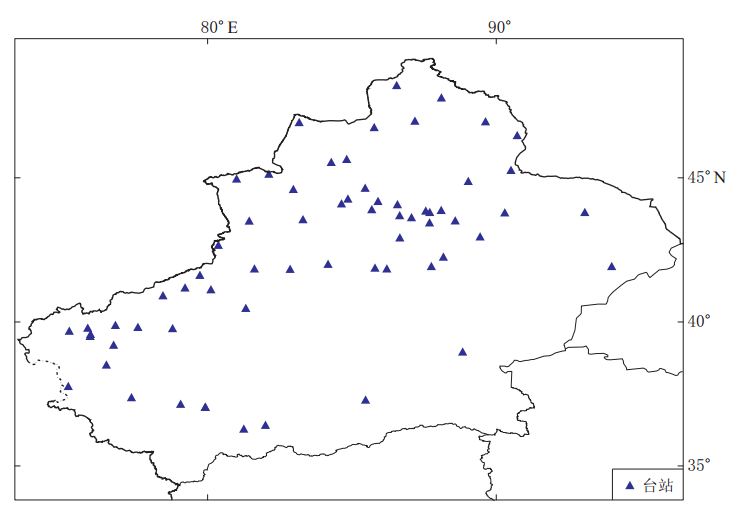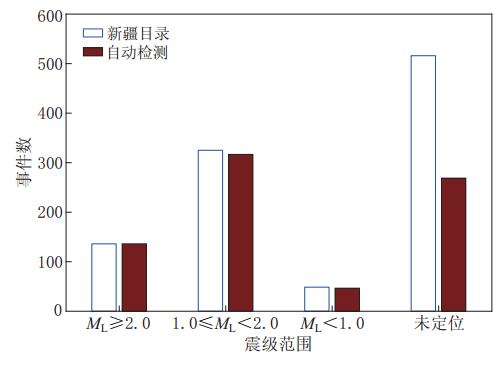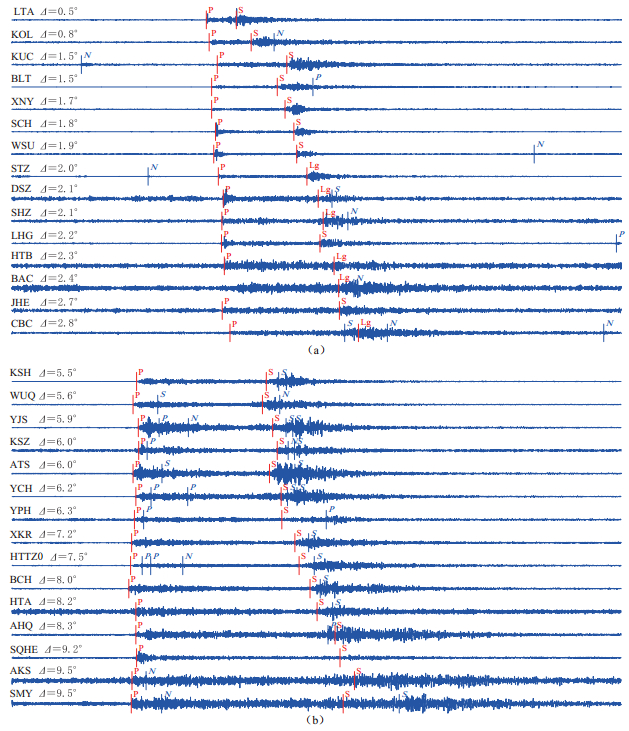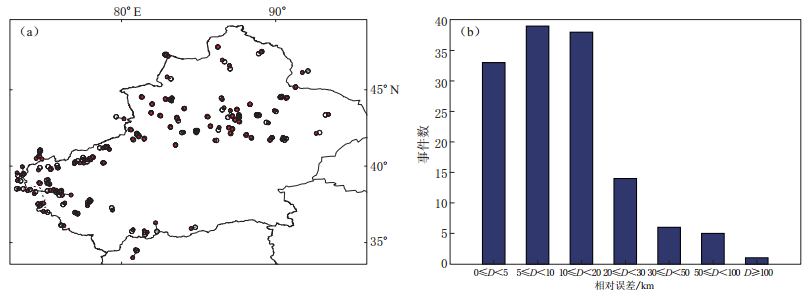A novel technique for automatic seismic data processing using both integral and local features of seismograms
-
摘要: 提出一种基于信号整体与局部特征的地震数据自动处理新方法, 该方法不同于以往仅采用包络线互相关来直接检测事件. 新方法依然按照检测、 识别、 关联和定位等4个步骤进行处理, 但在进行单个震相信号检测的同时, 也检测信号波列并利用其包络线特征来识别和关联震相. 文中详细阐述了数据处理过程中如何定义一个波列及抽取和应用其特征. 相关的数据处理技术目前已成功应用于区域台网的日常数据处理分析中. 作为例子, 给出了对新疆区域台网连续16天数据进行测试处理的结果. 实际应用结果表明, 这种新方法可以大幅度降低自动处理结果的误检、 漏检率, 在实际应用中具有很好的前景.Abstract: Reliable automation of data processing is of great significance for modern seismic monitoring. A novel technique for automatic seismic data processing which utilizes both integral and local features of seismograms was presented in this paper. However, unlike some previous efforts which seek to use envelope cross-correlation to detect seismic events directly, our technique keeps to follow the DIAL approach, i.e., by steps of signal detection, phase identification, association and event localization. However, in addition to detect signals corresponding to individual seismic phases, the new technique also detects continuous wave-trains and explores their envelope features for phase type identification and signal association. More concrete ideas about how to define wave-trains and combine them with various detections as well as how to measure and utilize their features in the seismic data processing were expatiated in the paper. This approach has been applied to the routine data processing of regional seismic networks for several years, and as an application example, here were presented test results for a 16 days' period using data from the Xinjiang regional seismic network. Practical application results show that the new technique can reduce both false alarm and missed event rate significantly and has good application prospects.
-
-
图 4 一次区域性地震在不同震中距台站的三分向信号记录
发震时间: 2010-06-01 04:29:29, 震中位置: 38.4°N、 74.0°E,震源深度: 156 km, 震级: ML3.1. 为提高在远距离台站上的信噪比, 波形全部经过4—8 Hz带通滤波. 图中的P、 S线分别对应于P波和S波的理论到时
Figure 4. Typical three-component seismograms recorded at regional distances
The waveforms are from an earthquake of ML3.1 occurred at 04:29:29 on 1 June, 2010. The epicenter of this earthquake is (38.4°N, 74.0°E) with focal depth 156 km. The waveform columns from left to right are 4—8 Hz band-pass filtered waveforms on vertical, south-to-north and west-to-east component respectively. The solid lines marked by P and S stand for theoretical arrival times of P and S
图 10 典型区域性事件自动处理结果实例
(a) 2010-06-09 10:58:59新疆和静ML2.6地震, 新疆局地震目录给出震中位置为42.33°N、 84.82°E, 自动处理结果误差约11 km; (b) 2010-06-09 16:01:08阿富汗兴都库什山区mb3.4地震, IDC REB中给出的震中位置为35.89°N、 69.57°E, 自动处理相对定位误差约31 km. 对每个事件, 图中显示的是最近的15个台站经0.5—5 Hz带通滤波后的垂直分量波形, 上面标出了对应台站的代码名称、 震中距及自动处理过程中实际触发的各个信号检测的到时位置及震相名称, 其中正体字母表示最终关联给相应事件的定义震相, 斜体字母代表未关联或未定义检测的震相, 其中N表示被识别为噪声的检测.
Figure 10. Examples of automatically processing results for two regional events
(a) Seismograms of the southern Xinjiang ML2.6 earthquake occurred at 10:58:59 on 9 June 2010. The epicenter is (42.33°N, 84.82°E) in Xinjiang seismic events catalog (XJEC), our automatically determined epicenter is 11 km away from it. (b) Seismograms of an mb3.4 earthquake occurred in the Hindu Kush region, Afghanistan, at 16:01:08 on 9 June 2010. For the epicenter of this earthquake is outside of Xinjiang seismic network, no information is given in the XJEC. However, the IDC REB epicenter of this earthquake is (35.89°N, 69.57°E), and our automatically determined result is 31 km away from it. For each event, 0.5—5 Hz band-pass filtered vertical component seismograms from the 15 closest stations are displayed. For each seismogram, respective recording station and epicentral distance are given at its left side, and all detections triggered within the displayed waveform time window are added, where the labels marked by upright letters are automatically associated defining phases for corresponding event and the labels marked by italics are unassociated ones. N stands for detections identified as noise by the software
图 11 新疆局地震目录中ML≥2.0地震自动定位结果与人工编目结果的比较(a)及震中相对误差分布(b)空心圆为新疆局地震目录给出的震中位置, 实心圆为本文自动定位结果, 实线相连表示是同一个事件
Figure 11. (a) Comparison of automatically determined epicenters in this study (red dot) with those in Xinjiang seismic events catalog (open blue circle) for events of ML≥2.0, wherer the marks linked together by short lines stand for results of same events; (b) Distribution of relative location errors between them
-
侯建民, 黄志斌, 余书明, 黄静, 代光辉, 赵永. 2009. 中国国家地震台网中心技术系统[J]. 地震学报, 31(6): 684-690. Hou J M, Huang Z B, Yu S M, Huang J, Dai G H, Zhao Y. 2009. Technical system in National Earthquake Network Center of China[J]. Acta Seismologica Sinica, 31(6): 684-690 (in Chinese).
金星, 廖诗荣, 陈绯雯. 2007. 区域数字地震台网实时速报系统研究[J]. 地震地磁观测与研究, 28(1): 64-72. Jin X, Liao S R, Chen F W. 2007. The test running of Real-time Earthquake Information System for province-level seismic network[J]. Seismological and Geomagnetic Observation and Research, 28(1): 64-72 (in Chinese).
李山有, 朱海燕, 武东坡, 宋晋东. 2006. 基于振幅和瞬时频率的震相自动识别方法[J]. 世界地震工程, 22(4): 1-4. Li S Y, Zhu H Y, Wu D P, Song J D. 2006. Automatic recognition of seismic phase based on amplitude and instantaneous frequency[J]. World Earthquake Engineering, 22(4): 1-4 (in Chinese).
刘希强, 周蕙兰, 曹文海, 李红, 李永红, 季爱东. 2000. 用于三分向记录震相识别的小波变换方法[J]. 地震学报, 22(2): 125-131. Liu X Q, Zhou H L, Cao W H, Li H, Li Y H, Ji A D. 2000. Identification method of seismic phase in three-component seismograms on the basis of wavelet transform[J]. Acta Seismologica Sinica, 22(2): 125-131 (in Chinese).
潘科, 刘援朝, 肖立萍. 2004. 辽宁数字地震台网地震参数自动处理系统的研制[J]. 东北地震研究, 20(4): 51-56. Pan K, Liu Y C, Xiao L P. 2004. Development on the automatic process system of earthquake parameter in Liaoning Digital Seismic Network[J]. Seismological Research of Northeast China, 20(4): 51-56 (in Chinese).
王海军, 刘贵忠. 2007. 基于支持向量机的信号自动检测算法[J]. 地震学报, 29(1): 85-94. Wang H J, Liu G Z. 2007. Automatic signal detection based on Support Vector Machine[J]. Acta Seismologica Sinica, 29(1): 85-94 (in Chinese).
张诚鎏. 2010. 地震信号识别和关联技术研究[D]. 西安: 西北核技术研究所: 1-71. Zhang C L. 2010. Study on Seismic Phases Identification and Association[D]. Xi'an: Northwest Institute of Nuclear Technology: 1-71 (in Chinese).
张范民, 李清河, 张元生, 盛国英, 范兵. 1998. 利用人工神经网络理论对地震信号及地震震相进行识别[J]. 西北地震学报, 20(4): 43-49. Zhang F M, Li Q H, Zhang Y S, Sheng G Y, Fan B. 1998. The seismic signal and phase recognition by using artificial neural network theory[J]. Northwestern Seismological Journal, 20(4): 43-49 (in Chinese).
Ahmed A, Sharma M L, Sharma A. 2007. Wavelet based automatic phase picking algorithm for 3-component broadband seismological data[J]. JSEE: Spring and Summer, 9(1): 15-24.
Allen R V. 1978. Automatic earthquake recognition and timing from single traces[J]. Bull Seismol Soc Am, 68(5): 1521-1532.
Anant K S, Dowla F U. 1997. Waveform transform methods for phase identification in three-component seismograms[J]. Bull Seismol Soc Am, 87(6): 1598-1612.
Arora N S, Given J, Tomuta E, Russell S, Spiliopoulos S. 2012. Analyst evaluation of model-based Bayesian seismic monitoring at the CTBTO[C]//Proceedings of the 2012 Monitoring Research Review: Ground-Based Nuclear Explosion Monitoring Technologies. New Mexico: National Nuclear Security Administration, I(LA-UR-12-24325): 91-199.
Arrowsmith S J, Whitaker R, Katz C, Hayward C. 2009. The F-detector revisited: An improved strategy for signal detection at seismic and infrasound arrays[J]. Bull Seismol Soc Am, 99(1): 449-453.
Baer M, Kradolfer U. 1987. An automatic phase picker for local and teleseismic events[J]. Bull Seismol Soc Am, 77(4): 1437-1455.
Bai C Y, Kennett B L N. 2000. Automatic phase-detection and identification by full use of a single three-component broadband seismogram[J]. Bull Seismol Soc Am, 90(1): 187-198.
Bai C Y, Kennett B L N. 2001. Phase identification and attribute analysis of broadband seismograms at far-regional distances[J]. J Seism, 5(2): 217-231.
Cansi Y. 1995. An automatic seismic event processing for detection and location: The PMCC method[J]. Geophys Res Lett, 22(9): 1021-1024.
Dai H, Macbeth C. 1995. Automatic picking of seismic arrivals in local earthquake data using an artificial neural network[J]. Geophys J Int, 120(3): 758-774.
Der Z A, Shumway R H. 1999. Phase onset time estimation at regional distances using the CUSUM-SA algorithm[J]. Phys Earth Planet Int, 113(1): 227-246.
Draelos T J, Ballard S, Young C J, Brogan R A. 2012. Refinement and testing of the probabilistic event detection, association, and location algorithm[C]//Proceedings of the 2012 Monitoring Research Review: Ground-Based Nuclear Explosion Monitoring Technologies. New Mexico: National Nuclear Security Administration, I(LA-UR-12-24325): 221-231.
Earle P, Shearer P. 1994. Characterization of global seismograms using an automatic-picking algorithm[J]. Bull Seismol Soc Am, 84(2): 366-376.
Evans J, Allen S. 1983. A teleseismic-specific detection algorithm for single short-period traces[J]. Bull Seismol Soc Am, 73(4): 1173-1186.
Hildyard M W, Nippress S E J, Rietbrock A. 2008. Event detection and phase picking using a time-domain estimate of predominante period Tpd [J]. Bull Seismol Soc Am, 98(6): 3025-3032.
IDC. 1999. IDC Processing of Seismic, Hydroacoustic, and Infrasonic Data. IDC Document[M/OL]. [1999-03-12]. http://www.rdss.info/librarybox/idcdocs/downloads/521.pdf.
Inclán C, Tiao G C. 1994. Use of cumulative sums of squares for retrospective detection in the changes of variance[J]. J Amer Statist Assoc, 89(427): 913-923.
Joswig M. 1990. Pattern recognition for earthquake detection[J]. Bull Seismol Soc Am, 80(1): 170-186.
Kamigaichi O. 1992. A fully automated method for determining the arrival times of seismic waves and its application to an on-line processing system, GSE/Japan/40[C]//34th GSE Session. July, 1992, Geneva.
Kedrov O K, Ovtchinnikov V M. 1990. An online analysis system for three-component seismic data: Method and preliminary results[J]. Bull Seismol Soc Am, 80(1): 2053-2071.
Küperkoch L. 2010. Automated Recognition, Phase Arrival Time Estimation, and Location of Local and Regional Earthquakes[D]. Bochum: Fakultät für Geowissenschaften, Ruhr-Universität Bochum: 1-133.
Küperkoch L, Meier T, Lee J, Friederich W, EGELADOS Working Group. 2010. Automated determination of P-phase arrival times at regional and local distances using higher order statistics[J]. Geophys J Int, 181(2): 1159-1170.
Le Bras R, Russell S, Arora N, Miljanovic V. 2011. Testing and evaluation of the false events identification (FEI) and vertically integrated seismic association (VISA) projects[C]//Proceedings of the 2011 Monitoring Research Review: Ground-Based Nuclear Explosion Monitoring Technologies. Arizona: National Nuclear Security Administration, I(LA-UR-11-04823): 313-321.
Moore D A, Mayeda K M, Myers S M, Seo M J, Russell S J. 2012. Progress in singal-based bayesian monitoring[C]//Proceedings of the 2012 Monitoring Research Review: Ground-Based Nuclear Explosion Monitoring Technologies. Arizona: National Nuclear Security Administration, I(LA-UR-11-04823): 263-273.
Pearce R G, staff, Monitoring Data Analysis Section, IDC. 2009. Exploiting the skills of waveform data and analysts in the quest for improved automatic processing[C/OL]//ISS09 Conference. 10-12 June, 2009, Vienna. [2009-06-20]. http://www.ctbto.org/fileadmin/user_upload/ISS_2009/Poster/DM-12A%20(PTS)%20-%20Robert_Pearce%20etal.pdf.
Procopio M J, Young C J, Lewis J E. 2009. Using machine learning to improve the efficiency and effectiveness of automatic nuclear explosion monitoring system[C]//Proceedings of the 2009 Monitoring Research Review: Ground-Based Nuclear Explosion Monitoring Technologies. Arizona: National Nuclear Security Administration, Ⅰ(LA-UR-09-05276): 788-797.
Research Required to Support Comprehensive Nuclear Test Ban Treaty Monitoring. 1997. Panel on Basic Requirements in Support of Comprehensive Test Ban Monitoring[M]. Washington DC: National Academy Press: 49-82.
Roberts R G, Christoffersson A, Cassidy F. 1989. Real-time event detection, phase identification and source location estimation using single-station three-component seismic data[J]. Geophys J, 97(3): 471-480.
Ryzhikov G A, Biryulina M S, Husebye E S. 1996. A novel approach to automatic monitoring of regional seismic events[J]. IRIS Newsletter, XV: 12-14..
Saragiotis C D, Hadjileontiadis L J, Panas S M. 2002. PAI-S/K: A robust automatic seismic P phase arrival identification scheme[J]. IEEE Trans Geosci Remote Sens, 40(6): 1395-1404.
Selby N D. 2008. Application of a generalized F detector at a seismometer array[J]. Bull Seismol Soc Am, 98(5): 2469-2481.
Sleeman R, van Eck T. 1999. Robust automatic P-phase picking: An online implementation in the analysis of broadband seismogram recordings[J]. Phys Earth Planet Int, 113(1): 265-275.
Stefano R D, Aldersons F, Kissling E, Baccheschi P, Chiarabba C, Giardini D. 2006. Automatic seismic phase picking and consistent observation error assessment: Application to the Italian seismicity[J]. Geophys J Int, 165(1): 121-134.
Suteau-Henson A. 1991. Three-component analysis of regional phases at NORESS and ARCESS: Polarization and phase identification[J]. Bull Seismol Soc Am, 81(6): 2419-2440.
Tibuleac I, Herrin E, Britton J, Shumway R, Rosca C. 2003. Automatic determination of secondary seismic phase arrival times using wavelet transforms[J]. Seism Res Lett, 74(6): 884-892.
Tong C. 1995. Characterization of seismic phases: An automatic analyzer for seismograms[J]. Geophys J Int, 123(3): 937-947.
Trnkoczy A. 1999. Understanding and parameter setting of STA/LTA trigger algorithm[G]//IASPEI: New Manual of Seismological Observatory Practice. Postsdam: GeoForschungsZentrum: 1003-1020.
Wang J. 2002. Adaptive training of neural networks for automatic seismic phase identification[J]. Pure Appl Geophys, 159(5): 1021-1041.
Wang J, Teng T-L. 1995. Artificial neural network-based seismic detector[J]. Bull Seismol Soc Am, 85(1): 308-319.
Wang J, Teng T-L. 1997. Identification and picking of S phase using an artificial neural network[J]. Bull Seismol Soc Am, 87(5): 1140-1149.
Withers M, Aster R, Young C, Beirger J, Harris M, Moore S, Trujillo J. 1998. A comparison of select trigger algorithms for automated global seismic phase and event detection[J]. Bull Seismol Soc Am, 88(1): 95-106.
Zhang H, Thurber C, Rowe C. 2003. Automatic P-wave arrival detection and picking with multiscale wavelet analysis for single-component recordings[J]. Bull Seismol Soc Am, 93(5): 1904-1912.
Zhao Y, Takano K. 1999. An artificial neural network approach for broadband seismic phase picking[J]. Bull Seismol Soc Am, 89(3): 670-680.





 下载:
下载:










